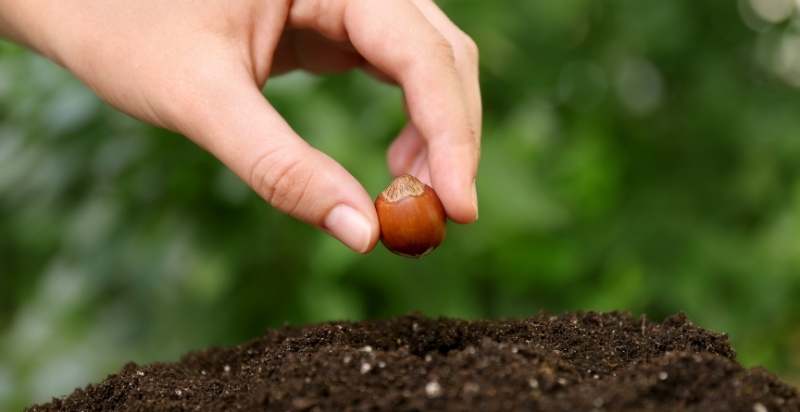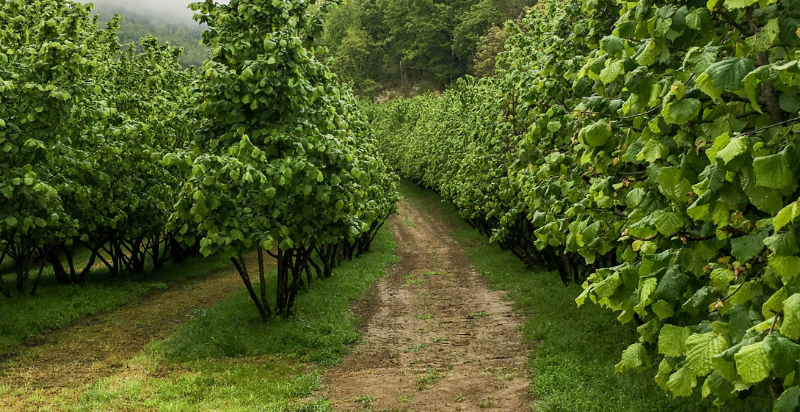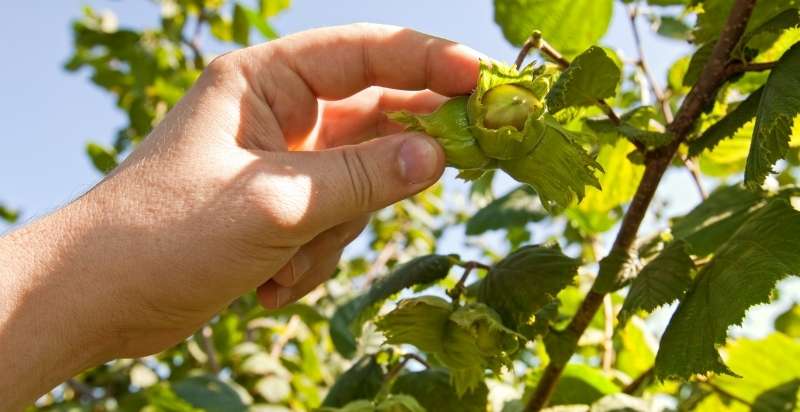Hazelnuts are a type of nut that is typically enjoyed roasted and salted. They can also be used in various sweet and savory dishes or eaten on their own as a healthy snack.
While hazelnuts are most commonly found in stores, did you know that it is quite easy to grow your hazelnuts at home? With a little bit of know-how, you can enjoy fresh hazelnuts right from your backyard! So let’s start with the basics.
What are Hazelnuts?
Hazelnuts are the edible nuts of the hazel and therefore include any of the nuts deriving from species of the genus Corylus, especially the nuts of the species C. avellana. They are also known as cobnuts or filberts, depending on which part of the world you come from.
Interestingly, more than 99% of commercial hazelnut production is concentrated in two countries – Turkey and Italy. Turkey is the largest producer, providing around 75% of the world’s hazelnuts, followed by Italy, with around 20%. The remaining 5% is produced in the US, Azerbaijan, Georgia, Iran, Chile, and Syria.

Hazelnuts History
The hazelnut is thought to have originated in Asia Minor and the Caucasus region. It is mentioned in Greek mythology and has been cultivated for centuries in Europe.
In Italy, hazelnuts are known as nocciola, while in Spain, they are referred to as Svetlana. In Germany, they are called Haselnuss, while in France, they are known as noisette. The word “hazelnut” derives from the Old English hæselnutu, which means “nut of the hazel tree.”
Hazelnuts were brought to North America by European settlers in the 1600s and have been grown commercially there since the early 1800s. The majority of hazelnuts grown in the United States are used for export.
The Hazelnut Tree:
Hazelnuts are produced by a deciduous shrub or small tree that can reach a height of 15 meters (49 feet). The leaves of the hazelnuts are oval-shaped and have toothed edges. Its flowers are small and yellow, and they bloom in the spring. It is encased in a hard shell surrounded by a green husk.
The hazelnut tree is found in temperate regions worldwide, including Europe, Asia, North America, and parts of Africa. The world’s greatest hazelnut producer is Turkey, followed by Italy and the United States.
Hazelnuts Nutrition:
Hazelnuts are a good source of fiber, protein, vitamins, and minerals, and they are particularly rich in vitamin E, manganese, and copper. It also contains high arginine levels, an amino acid shown to increase blood flow and improve cardiovascular health.
One ounce (28 grams) of hazelnuts contains the following:
- Calories: 176
- Protein: 4 grams
- Fat: 17 grams
- Carbs: 4 grams
- Fiber: 3 grams
- Vitamin E: 7% of the Daily Value (DV)
- Manganese: 22% of the DV
- Copper: 20% of the DV
In addition to the nutrients listed above, hazelnuts contain small amounts of calcium, iron, potassium, and magnesium.
Health Benefits Of Hazelnuts:
Hazelnuts are a good source of several important vitamins and minerals for health. Here are some of the potential health benefits of consuming it:
1. Heart health
The high levels of monounsaturated fat, vitamin E, copper, and manganese in hazelnuts may help protect against heart disease. Each of these nutrients is associated with a decreased risk of cardiovascular disease. Additionally, the amino acid arginine found in hazelnuts has been shown to improve blood flow and reduce the risk of heart disease.
2. Brain Health
Vitamin E is a powerful antioxidant linked to a lower risk of cognitive decline and Alzheimer’s disease. Hazelnuts are also a good source of copper, another nutrient that helps protect the brain from damage.
3. Cancer prevention
The antioxidants present in hazelnuts may help protect against cancer. According to certain studies, those who consume more foods rich in antioxidants have a lower risk of developing cancer. Additionally, the high levels of vitamin E in hazelnuts may help protect against prostate cancer.
4. Weight loss
A good source of fiber is hazelnuts, which can help promote weight loss by making you feel fuller for longer. Additionally, hazelnuts’ protein and healthy fats can help promote a healthy weight by helping regulate metabolism and blood sugar levels.
5. Skin health
The antioxidants present in hazelnuts may help protect the skin from damage. Additionally, high levels of vitamin E can help improve skin health by reducing inflammation and boosting collagen production.
Steps To Grow Hazelnuts :
If you are thinking of growing hazelnuts, you should know a few things. This guide will cover the basics of hazelnut cultivation, including species selection, planting, and care. Along with troubleshooting advice, we’ll discuss some typical issues that could come up while growing.
1. Species Selection
There are two main types of hazelnut trees: American and European.
American Hazelnut Trees:
American hazelnut trees (Corylus americana) are native to North America and can be found naturally from Canada to Georgia. They typically grow to a height of 15-20 feet (4.5-6 meters) and have a spread of 10-12 feet (3-3.6 meters).
The leaves of American hazelnut trees are oval-shaped and have toothed edges. The tree’s fruits are round, green nuts that mature to a brown color.
European Hazelnut Trees:
European hazelnut trees (Corylus avellana) are native to Europe and Asia Minor. They typically grow to 30-40 feet (9-12 meters), with a spread of 20-30 feet (6-9 meters).
The leaves of European hazelnut trees are oblong-shaped and have double-toothed edges. The tree’s fruits are also oblong, but they tend to be flatter than those of American hazelnut trees. European hazelnuts mature to a brown color.
Hybrid Hazelnut Trees:
There are also hybrid hazelnut trees created by crossing American and European species. These hybrids are typically sterile and cannot produce fruits on their own. However, they can be grafted onto American or European hazelnut trees to create a tree that produces both types of nuts.
Selecting a hazelnut tree species will help, considering your climate and soil type. American hazelnut trees are more tolerant of cold weather and can grow in a broader range of soil types than European hazelnut trees. American hazelnut trees may be a better option if you live in an area with cold winters or poor soil quality. Hazelnuts adapted to USDA Hardiness Zones 4-9, but some varieties can even grow in Zone 3.
On the other hand, European hazelnut trees tend to produce larger nuts than American hazelnut trees, and they also have a higher yield, meaning that they produce more nuts per tree. European hazelnut trees may be the best option to produce many nuts.
2. Planting
Hazelnuts can be grown in containers or on the ground. If you live in an area with cold winters, it is best to grow your hazelnut tree in a container that can be moved indoors. This will protect the tree from the cold and allow you to control the tree’s environment.
When planting hazelnuts, it is important to space the trees properly. American hazelnut trees should be planted 10-15 feet (3-4.5 meters) apart, while European hazelnut trees should be planted 20-30 feet (6-9 meters) apart. If you are planting more than one row of trees, space the rows 10-15 feet (3-4.5 meters) apart for American hazelnuts and 20-30 feet (6-9 meters) apart for European hazelnuts.
It is also important to plant hazelnut trees in an area that receives full sun. Hazelnuts need at least six hours of sunlight per day to produce a good crop of nuts.

3. Care
Once your hazelnut trees are planted, you must water them regularly. Water the trees deeply once a week, providing each tree with 10-15 gallons (38-57 liters) of water. If you live in an area with low rainfall, you may need to water the trees more frequently.
Hazelnut trees also need to be fertilized regularly. Apply a balanced fertilizer two or three times per year, depending on the fertilizer’s instructions.
It is also important to prune hazelnut trees regularly. American hazelnut trees should be pruned in late winter or early spring, while European hazelnut trees should always be pruned in late summer or early fall. Pruning helps to promote new growth and keep the tree healthy.

4. Harvesting
Hazelnuts are typically ready to harvest in late summer or early fall. The nuts will fall from the tree when ripe so that you can collect them from the ground. You can also shake the tree to release the nuts.
If you want to store the hazelnuts for later use, allow them to dry completely before storing them in an airtight container. It can be stored for up to six months.

Possible Side Effects of Eating Hazelnuts:
Generally speaking, hazelnuts are safe to eat and suitable for most people. However, as with all nuts, there is a risk of allergy. They are considered one of the most common tree nut allergies. Symptoms can range from mild (such as itching and redness around the mouth) to severe (such as difficulty breathing and anaphylaxis).
If you have a hazelnut allergy, it’s essential to avoid all foods that contain hazelnuts or any of their derivatives. This includes hazelnut oil, hazelnut spread, and hazelnut flour. Always check food labels carefully before purchasing or consuming anything.
Hazelnuts may also cause digestive problems in some people, which is more likely if consumed excessively or if you have eaten in large quantities. Symptoms include bloating, gas, stomach pain, and diarrhea. If you experience these symptoms after eating hazelnuts, limiting your intake or avoiding them altogether is best.
Hazelnuts In Cooking:
A versatile foodstuff, hazelnuts can be used in sweet and savory dishes. They can be eaten on their own as a snack or added to recipes for an extra boost of flavor and nutrition.
Some ways to use hazelnuts in cooking include:
-Chopping and adding them to salads or grain bowls
-Adding them to cookie or cake batter
-Using them to make hazelnut butter
-Roasting and topping chicken or fish with them
-Adding them to smoothies or milkshakes for a nutty flavor
-Making homemade hazelnut coffee creamer
Hazelnuts can also be used to make animal feed, and the nuts can be ground into a meal and mixed with other ingredients to create nutritious feed for chickens, cattle, and pigs.

Bottom Line
Hazelnuts are nutritious tree nuts rich in healthy fats, antioxidants, vitamins, and minerals. They offer some health benefits, including lower cholesterol levels and a reduced risk of heart disease and some chronic diseases.
Hazelnuts can be planted in containers or on the ground and need to be watered and fertilized regularly. They are generally ready to harvest in late summer or early fall. If you want to store the hazelnuts for later use, allow them to dry completely before storing them in an airtight container.
Hazelnuts are versatile and generally considered safe for consumption by most individuals. However, some people may be allergic to hazelnuts or experience digestive problems after eating them.
- Water Berries: Description, Flavor, Benefits, And Uses - June 18, 2024
- Everything You Wanted To Know About Sweetheart Cherries - June 17, 2024
- Indian Jujube: Description, Flavor, Benefits, And Uses - April 30, 2024
